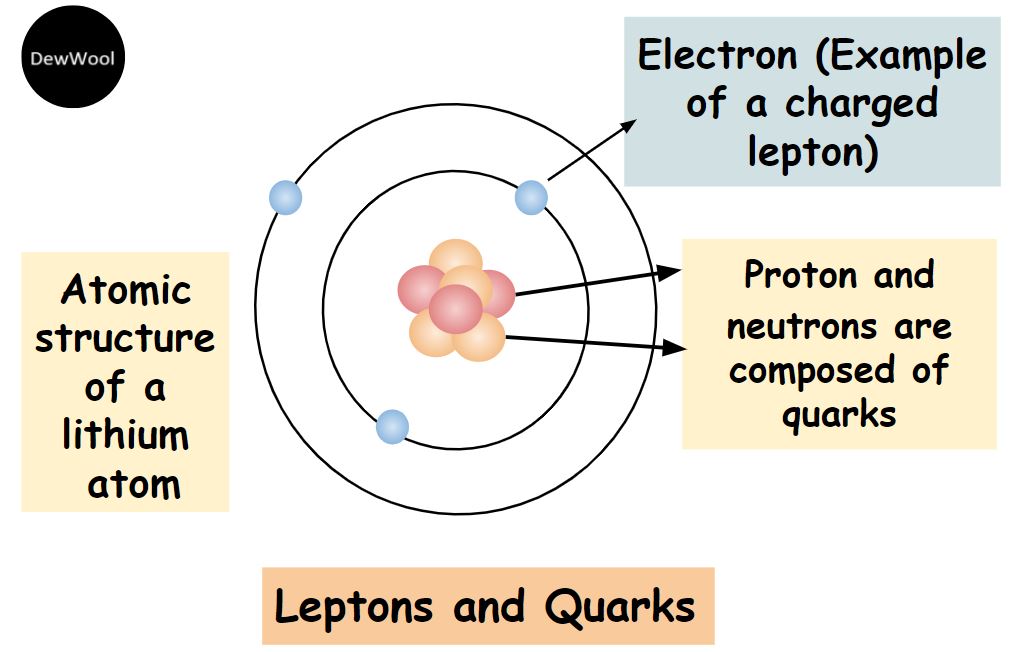Leptons, a fundamental constituent of matter, constitute an intriguing segment of the Standard Model of particle physics. Defined as elementary particles with a half-integer spin, leptons include a series of unique entities, namely the electron, muon, tau, and their corresponding neutrinos. This exposition explores the intricate nature of leptons, delving into their characteristics, interaction with other fundamental particles, and their overarching role in the fabric of the universe.
To elucidate what leptons are made of, one must first acknowledge that, as elementary particles, they are not composed of smaller constituents – unlike protons and neutrons, which are made up of quarks. Thus, the primary inquiry regarding leptons leads to an exploration of their intrinsic properties, interactions, and the profound implications these nuances harbor. Such exploration hints at the deeper layers of quantum field theory and the governing principles of the universe.
Leptons are categorized into three families, each containing a charged lepton and its associated neutrino: the electron and electron neutrino, the muon and muon neutrino, and the tau and tau neutrino. Charged leptons possess a negative electric charge, while neutrinos are electrically neutral, which renders them extremely elusive during interactions. This distinct separation between charged and neutral leptons underscores a fundamental aspect of particle physics: interactions predominantly occur via the weak and electromagnetic forces, exemplifying the rich tapestry of fundamental interactions in the universe.
Since leptons are considered point-like particles, they possess zero substructure. This designation means they do not possess size or shape in a classical sense, operating instead under the principles afforded by quantum mechanics. This lack of substructure distinguishes leptons from composite particles, allowing them to exhibit unique behaviors and properties, such as their inability to decay further into smaller particles. The stability of the electron, one of the most pivotal particles in the universe, derives from this characteristic, cementing its role in atomic structure and, by extension, in the genesis of matter.
Electrons, as the most prevalent and well-known leptons, serve not only as carriers of electric charge but also as a bridge between quantum mechanics and electromagnetism. Their interactions with atomic nuclei revitalize the very foundation of chemistry and thus the complexity of biological systems. Muons and tau particles, though sharing fundamental properties, are considerably less stable, succumbing to decay processes that transpire in fractions of a microsecond, underscoring the ephemeral nature of heavier leptons.
Neutrinos, the elusive partners of charged leptons, warrant special attention. They interact solely through the weak nuclear force, which renders them insusceptible to electromagnetic forces. This characteristic leads to their moniker as “ghost particles.” In their interactions, neutrinos play a pivotal role in processes such as beta decay, wherein a neutron decays into a proton, emitting an electron and an antineutrino. Neutrinos thus facilitate the transmutations of matter and its ensuing complexities, contributing to processes that govern stellar dynamics and nucleosynthesis in stars.
The fascination surrounding leptons extends beyond their intrinsic properties. They embody the enigma of mass generation, an insight deeply rooted in the Higgs mechanism. Through interactions with the Higgs field, leptons acquire mass, albeit to varying degrees, denoting a pivotal juncture in understanding the hierarchy problem in particle physics. The masses of the three generations of leptons differ drastically, raising fundamental questions regarding their origins and relationships amidst the broader spectrum of particles.
Additionally, leptons have been at the forefront of experimental discoveries that challenge existing paradigms. The observation of neutrino oscillation, for example, reveals that neutrinos can transform between types, which signifies they possess mass—contradicting long-held assumptions. This discovery not only challenges the robustness of the Standard Model but also opens a realm of possibilities regarding the nature of dark matter and the fundamental structure of the universe at large.
Another captivating aspect of leptons is their connection to symmetries and conservation laws in particle interactions. The conservation of lepton number, a principle that dictates that the total number of leptons must remain constant in a closed system, serves as a linchpin in theoretical frameworks. This principle, however, comes into question in certain proposed extensions of the Standard Model, prompting ongoing inquiry into lepton number violation and its implications for phenomena such as matter-antimatter asymmetry.
With advancements in particle accelerators and detectors, investigations into leptons and their interactions continue to expand the horizons of particle physics. The Large Hadron Collider (LHC) provides a stage for probing the limits of current understanding and unveils the enigmatic realms of beyond the Standard Model physics. Such experimental endeavors, accompanied by theoretical developments, resolve to unveil the intricate threads that weave leptons into the expansive tapestry of existence.
In summation, leptons are quintessential artefacts of the subatomic world. Their elemental status renders them simple yet profound, acting as the fundamental building blocks of matter, encapsulating myriad phenomena, and fostering questions that probe deep into the essence of physical reality. By elucidating their characteristics and interactions, one embarks on a journey through the realms of the smallest constituents of the universe, unveiling the extraordinary complexity that lies beneath the surface of apparent simplicity. Leptons, both individually and collectively, underscore the elegance and depth of fundamental physics, highlighting the symbiotic relationship between the quantum and cosmological realms.












